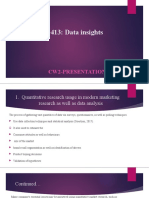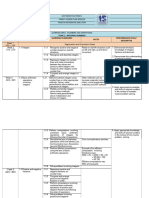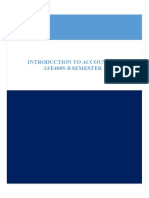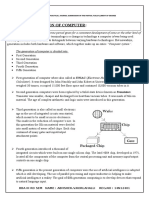Every Day (Mathematics) Occurrences
Uploaded by
tahiraEvery Day (Mathematics) Occurrences
Uploaded by
tahira"Mathematics is traditionally described as a
scientific
study of quantities,
Mathematics comprising their relationship,
and Numeracy: Differences
processes, as well as measurements represented in
and similarities between mathematics and Mathematics cultivates the numeracy skills that all students require in their private, professional, as a working understanding of baking ratios and proportions, like 250 ml oil as well as 2
well as social lives and also providing the foundations upon which mathematical expertise as well as
numbers as well as symbols. The examination of patterns eggs into 3/4 cup flour Source: (Kern, 2020)
numeracy professional applications are developed. Mathematics and numeracy are related in that they both
as well as connections is known as mathematics" demand us to utilise our understanding of numbers as well as number systems to solve issues. and subtract if the cookies are eaten
To figure out where to use these mathematic abilities throughout the preparation of the meal so that it
Grimley (2016) argues that both numeracy and mathematics deals with numbers, forms, as well as
is neither overcooked nor undercooked, numeracy skills would be required. Numeracy would also be
While numeracy is defined as the skill to deal with amounts, and also fundamental math abilities like additions, multiplication, division, as well as
utilized to determine if they needed to add or subtract measures to obtain the appropriate amount of
numbers. The Australian Curriculum defines numeracy as subtractions. They are both beneficial to a person's mental growth. In order to be successful and Every day (mathematics) occurrences
food for everybody when considering the number of persons they are preparing for.
develop confidence with in real world, math as well as numeracy both are needed.
"the information, skills, manners, and attitudes that Numeracy helps us to carry out everyday tasks such as shopping for food or telling the time and
Difference Similarities
reading a calendar. Functional numeracy is defined as having these kinds of numeracy abilities,
students need to apply mathematics in a variety of Mathematics Numeracy Similarities between
which allows numerate people to operate effectively in society.
both terms
situations." A study of measurement, One’s mathematical knowledge Both have Problem
quantities relationship and sets, and abilities, as well as their solving ability
properties utilizing symbols as application in everyday life
well as numbers (Siemon et al., (Siemon et al., 2015) The natural world is rich of fascinating mathematical phenomena; for example, a rainbow is a
stunning display of geometry painted all across sky in light beams.
2015)
Increasingly abstract and Concrete as well as practical An understanding and
There really is no consensus between scholars on what defines mathematics. platonic capability ability to use numbers
Provide Bases for being Life skill develops by thinking
Source: (Siemon et al., 2015) numerate mathematically
Requires critical thinking Assist to follow a cooking Contribute towards
According to Tipps, Johnson, and Kennedy (2011), the discipline of logical examination of numbers, recipe development of
form, arrangement, amount, measure, as well as many related ideas that encompasses geometry, individual’s mind
algebra, calculus and arithmetic, mathematical operations and computations is known as
mathematics.
Source: (Grimley, 2016)
Numeracy skills used in the real world
Charlesworth (2011) states that a four fundamental operations of arithmetic procedures within
mathematics include addition, subtraction, multiplication, as well as division. These are the
fundamental principles of mathematics, and they are utilised in the actual world for solving problems
and realising ideas. Recently, maths is often characterized as “a science that studies the
An example of numeracy in everyday life is cooking.
characteristics and patterns of abstract structures that it has created”. Aristotle believes that "the When cooking, the cook would
study of quantity?" is called mathematics. have to be using the mathematics of numbers to
understand the time, temperatures and Source:
measurements needed in the recipe. Through cooking,
The capacity to apply important mathematical ideas in daily life is known as numeracy (ACARA, the cook must use their knowledge of (teaching, 2019)
numbers or numerical information, calculations and
2018). It is a collection of arithmetic abilities acquired via educational means and used to diagrams to work out the ratio and
In addition, a mathematical approach to daily events may include notions like chance and
measurements of ingredients and applying it to the
demonstrate the ability to use these skills in the actual world. Numeracy involves identifying when process of cooking. Numeracy skills probability; what are the chances of it raining today? While mathematical principles may aid in the
math may be used, selecting appropriate mathematical ideas, patterns, formulae, and so on, and then would be needed to work out where to apply these
prediction of weather patterns, numeracy abilities are often required to measure and record
mathematic skills during the cooking of
the food, so it is not over cooked or undercooked. meteorological variables such as temperature, wind speed, and rainfall.
being able to understand the results. Doig, McRae, and Rowe (2003) described in its book that
Numeracy would also be used when taking
Numeracy skills include addition as well as subtraction and also mathematical operations like into consideration the amount of people they are The wings of a butterfly is an example of symmetry in insects and animals. The Fibonacci sequence,
cooking for, deciding if they need to add or
estimate as well as round. subtract the measurements to get the right proportion a numerical pattern seen on flower petals, pinecones, and succulents, is another example of nature's
of food for everyone. marvels. The sequence of Fibonacci can be defined as a integers set wherein the total of the two
Furthermore, apart from numeracy, “mathematics doesn't get to address the actual world since it Baking a chocolate chip cookies is an application of
preceding numbers makes a third number, for instance, 1,1, 2, 3, 5, 8, 13, 21, 34,55 and so on.
concentrates on abstract structures as well as concepts irrespective of their possible applications, numeracy as well as mathematics in daily life. Baking
inside the kitchen demands a high degree of mathematical understanding. While preparing, the baker
while numeracy refers to application of mathematics in an accurate way” (Siemon et al., 2015).
must use mathematical calculations to comprehend the time, temperatures, as well as measures
Patterns and connections are used in mathematics. Numeracy refers to a person's ability, competence,
required throughout the recipe, such as
and willingness to utilize numbers in daily situations (Doig et al., 2003).
recipe conversion by Celsius to the Fahrenheit
estimating the amount of time it will take to cook
Source: (Bea.miau, 2011) Source: (Allen, 2020)
References
ACARA. (2018). Australian Curriculum: F-10 overview:
Numeracy: Australian Curriculum .8.4. . Retrieved from
Retrieved from https://www.australiancurriculum.edu.au/f-
10-curriculum/general-capabilities/numeracy/
Allen, S. (2020). Mater Fibonacci: The man who changed math.
Retrieved from https://fibonacci.com/nature-golden-ratio/
Bea.miau. (2011). Example of reflection symmetry in the Bilateria.
Retrieved from
https://en.wikipedia.org/wiki/Symmetry_(geometry)
Charlesworth, R. (2011). Experiences in math for young children:
Cengage Learning.
Doig, B., McRae, B., & Rowe, K. (2003). A good start to
numeracy: Effective numeracy strategies from research and
practice in early childhood.
Grimley, M. (2016). Week 2 - Numeracy vs mathematics
(EDU10003 The World of Maths) [Video file]. Retrieved
from Retrieved from
https://cdnapisec.kaltura.com/html5/html5lib/v2.42/mwEm
Mathematics and Numeracy
bedFrame.php/p/691292/uiconf_id/24456822/entry_id/0_a9
wkotpx?
wid=_691292&iframeembed=true&playerId=kaltura_playe
r_1430789825&entry_id=0_a9wkotpx&flashvars[akamaiH
D.loadingPolicy]=preInitialize&flashvars[akamaiHD.async
Init]=true&flashvars[streamerType]=hdnetwork
Kern, D. (2020). Teaching Math with Baking. Retrieved from
https://www.crazyforcrust.com/teaching-math-with-baking/
Siemon, D., Beswick, K., Brady, K., Clark, J., Faragher, R., &
Warren, E. (2015). Teaching mathematics: Foundations to
middle years: Oxford University Press.
teaching, A. (2019). A Plus Teaching Resources. Retrieved from
https://aplusteachingresources.com.au/product/rainbow-
facts-printables/
Tipps, S., Johnson, A., & Kennedy, L. M. (2011). Guiding
children’s learning of mathematics: Cengage Learning.
You might also like
- Principles and Standards For School Mathematics (PK2-NO) - 94-104No ratings yetPrinciples and Standards For School Mathematics (PK2-NO) - 94-10411 pages
- Principles and Standards For School Mathematics (NCTM) - 230-237No ratings yetPrinciples and Standards For School Mathematics (NCTM) - 230-2378 pages
- Numeracy Learning Matrix and Unpacking NumeracyNo ratings yetNumeracy Learning Matrix and Unpacking Numeracy10 pages
- Curriculum Design For Diploma in Secondary Teacher Education MathematicsNo ratings yetCurriculum Design For Diploma in Secondary Teacher Education Mathematics123 pages
- Athematics: ICSE Class Maths Syllabus 2020-21No ratings yetAthematics: ICSE Class Maths Syllabus 2020-2114 pages
- ICSE Class 7 Maths Reduced Syllabus 2020 21No ratings yetICSE Class 7 Maths Reduced Syllabus 2020 2110 pages
- Study Resources NC Math 1 (HS Cred) - 23-24 - Hughes (21092Y0900)No ratings yetStudy Resources NC Math 1 (HS Cred) - 23-24 - Hughes (21092Y0900)1 page
- DLP Math 5 First Grading (Lesson 2 and 3)No ratings yetDLP Math 5 First Grading (Lesson 2 and 3)3 pages
- Welcome TO . Business Mathematics & ApplicationsNo ratings yetWelcome TO . Business Mathematics & Applications48 pages
- PFEQ-progression-apprentissages-mathematique-primaire-ANNo ratings yetPFEQ-progression-apprentissages-mathematique-primaire-AN24 pages
- Best Advice 3 0 Big Ideas in Number Overview PDFNo ratings yetBest Advice 3 0 Big Ideas in Number Overview PDF7 pages
- Professional Development - Mathematical MindsetsNo ratings yetProfessional Development - Mathematical Mindsets1 page
- OBE SYLLABUS College and Advance Algebra 2022100% (1)OBE SYLLABUS College and Advance Algebra 20228 pages
- Sukatan-Pelajaran-Mathematics-KBSM-V-English-3No ratings yetSukatan-Pelajaran-Mathematics-KBSM-V-English-32 pages
- Year 2 Semester Plan Mathematics AY 2020-21No ratings yetYear 2 Semester Plan Mathematics AY 2020-2116 pages
- Importance of Mathematics in Our Daily Life Brochure - Group 1No ratings yetImportance of Mathematics in Our Daily Life Brochure - Group 12 pages
- Clarissa May - Module 1 Learning Activity 1No ratings yetClarissa May - Module 1 Learning Activity 113 pages
- ALGEBRA. A Mathematical Analysis Preliminary to CalculusFrom EverandALGEBRA. A Mathematical Analysis Preliminary to CalculusALIX AURORA FUENTES MEDINANo ratings yet
- Benefits of Advanced Technology in Supermarkets BusinessNo ratings yetBenefits of Advanced Technology in Supermarkets Business9 pages
- Introduction To Accounting Afe4005-B Semester 1No ratings yetIntroduction To Accounting Afe4005-B Semester 16 pages
- Quine: Perspectives On Logic, Science and Philosophy: Interview by Bradley Edmister and Michael OjsheaNo ratings yetQuine: Perspectives On Logic, Science and Philosophy: Interview by Bradley Edmister and Michael Ojshea11 pages
- FALLSEM2018-19 - MAT5009 - TH - TT531 - VL2018191004951 - Reference Material I - 01 - MAT 5009 - ADVANCED COMPUTER ARITHMETIC PDFNo ratings yetFALLSEM2018-19 - MAT5009 - TH - TT531 - VL2018191004951 - Reference Material I - 01 - MAT 5009 - ADVANCED COMPUTER ARITHMETIC PDF13 pages
- Anna University - Chemical Engineering Syllabus100% (1)Anna University - Chemical Engineering Syllabus101 pages
- 18-12-2024_Sr.S60_Elite, Target & LIIT-BTs_2nd Year Syllabus_Jee-Main-GTM-06&01_Q.PAPER100% (2)18-12-2024_Sr.S60_Elite, Target & LIIT-BTs_2nd Year Syllabus_Jee-Main-GTM-06&01_Q.PAPER22 pages
- Senior Model-A&b Pta-17 Maths Npyq-24 - PNo ratings yetSenior Model-A&b Pta-17 Maths Npyq-24 - P28 pages
- Cohomology of Arithmetic Groups, L-Functions and Automorphic - T. Venkatamarana PDFNo ratings yetCohomology of Arithmetic Groups, L-Functions and Automorphic - T. Venkatamarana PDF132 pages
- Implementation of MAC Unit Using Booth Multiplier & Ripple Carry AdderNo ratings yetImplementation of MAC Unit Using Booth Multiplier & Ripple Carry Adder3 pages
- From Gatekeeper To Gateway: The Role of Quantitative ReasoningNo ratings yetFrom Gatekeeper To Gateway: The Role of Quantitative Reasoning8 pages

































































































